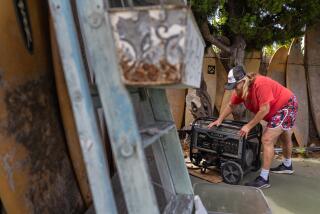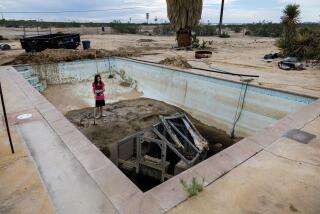Gradually, Grand Forks Digs Itself Out
- Share via
GRAND FORKS, N.D. — The water is gone now. What remains is a city of garbage. Sidewalks are hidden under trash mountains. The streets tremble under the wheels of dump trucks. Every day, the mounds of refuse grow higher, as if there is nothing in these sodden houses left to salvage.
The trucks fill, load after groaning load, and rumble west. Two miles outside of town, they line up, waiting to spill the detritus of 50,000 lives into the clay bowels of a waste Matterhorn. Overhead, shrieking gulls and scavenger birds wheel in the air, impatiently eyeing the city’s leftovers.
A month after Grand Forks’ fall to the Red River, the massive $3-million cleanup is exposing the sweeping damage that the flood waters obscured. Slowly, residents are returning to their homes like liberated prisoners, desperate to put their lives back together. But the piles of soggy wood, battered freezers and warped photo albums taunt them with the certainty that things will never be the same.
“I know this is my house,” said railroad brakeman Clark Thomson, as friends from a local church gutted what once had been his family’s dream home. “But when you walk inside, with the smell and the mold and everything gone, it’s like we never lived here.”
A tentativeness has replaced the can-do spirit that Grand Forks residents mustered in the first days after the flood. Even as city officials lobbied legislators in Washington this week to free up $400 million for flood relief, residents were anguishing over the dimensions of a newly proposed dike project that could displace up to 2,000 of their homes and swallow up much of the city’s faded downtown district--all to ensure that a flood as devastating as last month’s will never happen again.
Army engineers and Grand Forks officials tout the $180-million levee project as the only sensible way to reassure the business community and persuade new firms to locate in a city now infamously prone to the perils of nature. But the remedy may be so drastic--transforming a downtown and riverfront that many here prized for their serene quaintness--that some officials are resigned to seeing residents and business owners drift away by the thousands.
An Exodus Estimated at 10% of Population
At least 10% of the population likely will leave, an inevitable exodus that officials hope will not feed on itself. “We’re just hoping we can keep the numbers that low,” City Council President Tom Hagness said.
At the dairy he manages, Hagness’ office manager, Jackie Mitchell, worries whether she can stay in Grand Forks. Under the proposed dike project, the flood-soaked house she and her husband want to retire in would have to be sold to the government. Every morning, she lobbies Hagness to find some way to redraw the dike line away from her house. Mitchell is just one of hundreds of distressed homeowners who are pleading with city officials to save their waterlogged dwellings even as they work to repair them.
“If they take our home away, there’s no reason left for us to stay here,” Mitchell said.
About half of Grand Forks’ population has returned in some fashion, said Charles Grotte, a city public works official. In neighborhoods where water damage was slight, limited to basements and garages, some families have moved back, jury-rigging electric wiring for power and space heaters for warmth. Others are living out of campers parked in their driveways.
Each day, Clark and Debbie Thomson enter their soggy shell of a house after a short drive from an apartment they are renting for three months on the edge of town. Wearing rubber gloves and surgical masks to protect themselves from mold, they have removed a water-ruined freezer, smashed cabinets and armchairs, their 5-year-old daughter’s Barbie toy classroom and mounds of flaky drywall. Started a week ago, their sidewalk pile is nearly 5 feet high, dwarfed by 10-foot stacks deposited by their neighbors.
As busy as Clark Thomson has been, he is not itching to begin repairs. He is not even sure the family can return. The proposed dike would run in the alley right behind the red-shingle frame house. But even before he can decide whether he wants to live next to a flood wall, he needs to find out whether he can collect on the flood insurance he bought in March. It was supposed to go into effect April 21. But the Red River washed into his home the day before.
“It’s like no matter what you do right, you end up losing,” he said, still hopeful that Congress will pass an exemption allowing those who purchased insurance less than a month before the flood to get help.
Even if the insurance money comes, even if his house is on the right side of the new flood wall, the Thomsons are not so sure they want to stay--at least so close to the river. “The river’s a beautiful sight,” Debbie Thomson said, “but not when it’s in your living room.”
Several blocks north, Jerry and Marilyn Bakke have emptied their flooded basement of its soggy contents, stripped off rotting drywall and are almost ready to start repairs.
“It’s strange having to commute to your own house,” he said. “But at least we come here every day knowing we’re going to get back in. Think about all those poor people who don’t even know that.”
A retired painting contractor, Bakke is one of Grand Forks’ luckier residents. He knows an electrician.
It is the scarcity of electricians--not flood damage or the delay of essential city services--that is preventing most flood victims from living again in their homes.
Water, Sewage Systems Are Back
Despite earlier concerns that it could take up to two months before the town’s overwhelmed water and sewage plants could be revived, both systems were up and fully running this week. Grotte attributes the rapid recovery to the same flat city terrain that made Grand Forks easy prey to the flood waters. Even after the water plant shut down, fresh water remained in most of the town’s 200 miles of underground mains, staving off contamination.
“What helped was that most of the water lines are level, just like the city,” Grotte said. “That prevented the sewage from filling in--which is what would have happened if the pipes were on an angle.”
And the repair work moved quickly, speeded by 20 private crews brought in to buttress tired city employees. Patchwork wires still spool like entrails through the water plant and private contractors are there, taking care of functions--rewiring and drying crucial motors, filters and panels--once handled by computer. But the fresh water is flowing, Grotte said, “a lot faster than any of us expected.”
With essential services restored, most residents should be moving back in now. But few are, unable to find electricians to repair shorted-out basement panels. Many are on monthlong waiting lists. And law enforcement authorities have had to scramble to deter con artists from defrauding homeowners desperate to get their power on.
Fly-by-night contractors are being arrested for outstanding warrants at a rate of a dozen a day, Hagness said. “They come into town and just drive around,” he added. “There are so many people out there who’d do anything to get their power on. Soon as they see a truck that says ‘electrician,’ they flag it down, no matter how shady the guy inside is.”
Legion of Trucks, Earthmovers
Yet even the roving con men are outnumbered on the streets by the legion of trucks and earthmovers brought in to dispose of Grand Forks’ tons of rubble.
For a week now, a fleet of 140 dump trucks and garbage loaders has been shuttling back and forth from city streets to the town’s landfill. They will be at it for at least a month more, said Jim Gerszewski, the town’s solid waste supervisor.
At the dump site, Gerszewski sits inside a white trailer used as a scale house, watching the trucks shudder over the fill’s clay fields. There are so many trucks--and their return trips are so frequent--that he has given up trying to estimate the weight of their loads.
“All we can do is tally up the trucks,” he said. “They’re coming in and out of here so fast, sometimes we lose count.”
In a week, the trucks have piled as many heavy appliances--refrigerators, freezers, washers, dryers and ranges--in a 25-foot-high metal butte as normally mount up in a year at the landfill.
Driving by the pile, Gerszewski stopped short. He stared for a minute before moving on.
“My freezer’s in there somewhere,” he said. “And there’s more where that came from.”
More to Read
Sign up for Essential California
The most important California stories and recommendations in your inbox every morning.
You may occasionally receive promotional content from the Los Angeles Times.









